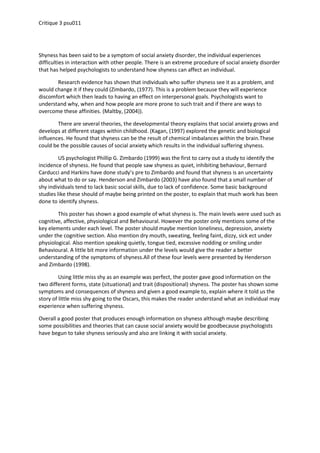Report
Share

Recommended
Recommended
More Related Content
Similar to Critique 3 indifidul diferneces
Similar to Critique 3 indifidul diferneces (19)
Does Psychology Make a Significant Differencein Our Lives

Does Psychology Make a Significant Differencein Our Lives
1. All of the following are common changes that occur in a.docx

1. All of the following are common changes that occur in a.docx
DirectionsIn the first part, each question should be answered.docx

DirectionsIn the first part, each question should be answered.docx
psychology and pedadogy about human lide and animal lide

psychology and pedadogy about human lide and animal lide
Games Essay Writing. Video games are good for you! Essay writing skills, Ess...

Games Essay Writing. Video games are good for you! Essay writing skills, Ess...
Critique 3 indifidul diferneces
- 1. Critique 3 psu011 Shyness has been said to be a symptom of social anxiety disorder, the individual experiences difficulties in interaction with other people. There is an extreme procedure of social anxiety disorder that has helped psychologists to understand how shyness can affect an individual. Research evidence has shown that individuals who suffer shyness see it as a problem, and would change it if they could (Zimbardo, (1977). This is a problem because they will experience discomfort which then leads to having an effect on interpersonal goals. Psychologists want to understand why, when and how people are more prone to such trait and if there are ways to overcome these affinities. (Maltby, (2004)). There are several theories, the developmental theory explains that social anxiety grows and develops at different stages within childhood. (Kagan, (1997) explored the genetic and biological influences. He found that shyness can be the result of chemical imbalances within the brain.These could be the possible causes of social anxiety which results in the individual suffering shyness. US psychologist Phillip G. Zimbardo (1999) was the first to carry out a study to identify the incidence of shyness. He found that people saw shyness as quiet, inhibiting behaviour, Bernard Carducci and Harkins have done study’s pre to Zimbardo and found that shyness is an uncertainty about what to do or say. Henderson and Zimbardo (2003) have also found that a small number of shy individuals tend to lack basic social skills, due to lack of confidence. Some basic background studies like these should of maybe being printed on the poster, to explain that much work has been done to identify shyness. This poster has shown a good example of what shyness is. The main levels were used such as cognitive, affective, physiological and Behavioural. However the poster only mentions some of the key elements under each level. The poster should maybe mention loneliness, depression, anxiety under the cognitive section. Also mention dry mouth, sweating, feeling faint, dizzy, sick ect under physiological. Also mention speaking quietly, tongue tied, excessive nodding or smiling under Behavioural. A little bit more information under the levels would give the reader a better understanding of the symptoms of shyness.All of these four levels were presented by Henderson and Zimbardo (1998). Using little miss shy as an example was perfect, the poster gave good information on the two different forms, state (situational) and trait (dispositional) shyness. The poster has shown some symptoms and consequences of shyness and given a good example to, explain where it told us the story of little miss shy going to the Oscars, this makes the reader understand what an individual may experience when suffering shyness. Overall a good poster that produces enough information on shyness although maybe describing some possibilities and theories that can cause social anxiety would be goodbecause psychologists have begun to take shyness seriously and also are linking it with social anxiety.
- 2. Critique 3 psu011 References Henderson, L., & Zimbardo, P. (2003).Shame and Anger in chronic shyness and social Anxiety Disorder. Kagan,J. (1997). Temperament and the reactions to unfamiliarity. Child Development, 68 (1), 139- 145 Maltby, J., Day, L., & Barber, L. (2004). Forgiveness and mental health variables: Interpreting the relationship using an adaptational-continuum model of personality and coping. Personality and Individual Differences, 37(8), 1629-1641. Zimbardo,P.G.(1999) Discontinuity theory: Cognitive and Social Searches for rationality and normality-may lead to madness. Advances in experimental social psychology, 31,345-486 Zimbardo, P.G. (1997). Shyness. What it is, what to do about it. Reading MA:Addison-Wesley. Zimbardo, P.G, &Radl, S. (1981) The shy child. New york: